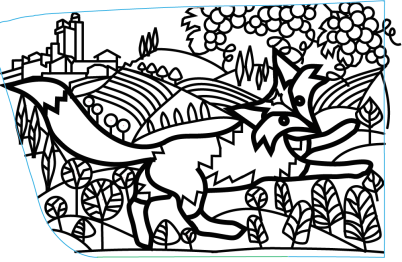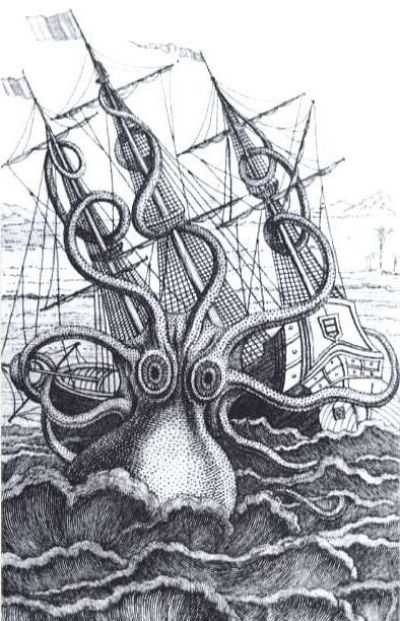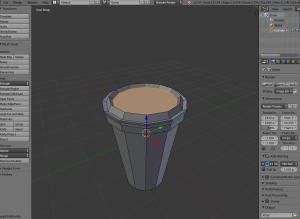Living in the Future with Blender and Shapeways
Posted: July 16, 2015 Filed under: Uncategorized Leave a commentI remember the very first time I saw a computer-generated image that actually looked awesome. It was in Scientific American, I think, probably in the late 1980’s, and it was a scene with a simple sphere and a single light source. The article discussed the “ray-tracing” software, a mind-blowing concept at the time. I think it took like a million hours to render the image–and it was AMAZING.
Fast-forward to the future, which we now live in. My son and I have been taking a class at Madison College to learn Blender, which is an incredibly robust open source 3D design software. We are going to make some projects to send off to be 3D printed at Shapeways, but Blender can also be used for animation and all kinds of 3D projects.
Look, I made a coffee cup! I love living in the future!
2015 Treinen Farm Corn Maze Design: Aesop’s Fable The Fox and the Grapes
Posted: June 29, 2015 Filed under: 2015 Corn Maze, Maze Design | Tags: 2015 Corn Maze, Aesop's, corn maze, cutting a maze, fox Leave a comment Today it the official first day of maze cutting for 2015! We’ve got the young crew out there setting up stakes in the grid of corn, and therefore, the pressure was on–I had to get the final touches on the corn maze design so Alan could take it to the printer for enlargement. So…he’s on his way to the printer! The design is official!
Today it the official first day of maze cutting for 2015! We’ve got the young crew out there setting up stakes in the grid of corn, and therefore, the pressure was on–I had to get the final touches on the corn maze design so Alan could take it to the printer for enlargement. So…he’s on his way to the printer! The design is official!
The design is the Aesop’s Fable The Fox and the Grapes. If you aren’t familiar with Aesop’s Fables, you’ll probably recognize the most well-known one: The Tortoise and the Hare. Here’s our favorite, though:
THE FOX AND THE GRAPES
A FOX one day spied a beautiful bunch of ripe grapes hanging from a vine trained along the branches of a tree. The grapes seemed ready to burst with juice, and the Fox’s mouth watered as he gazed longingly at them.
![[Illustration]](https://i0.wp.com/www.mainlesson.com/books/winter/aesop/zpage020.gif)
The bunch hung from a high branch, and the Fox had to jump for it, The first time he jumped he missed it by a long way. So he walked off a short distance and took a running leap at it, only to fall short once more. Again and again he tried, but in vain.
Now he sat down and looked at the grapes in disgust.
“What a fool I am,” he said. “Here I am wearing myself out to get a bunch of sour grapes that are not worth gaping for.”
And off he walked very, very scornfully.
There are many who pretend to despise and belittle that which is beyond their reach.
(The Aesop for Children, with pictures by Milo Winter, published by Rand McNally & Co., Chicago, 1919)
Treinen Farm Maze Design 2014 The Owl of Athena
Posted: August 6, 2014 Filed under: 2014 Corn Maze, Athena, Math in the maze, Maze Design, owls | Tags: Athena, corn maze, maze, mythology, owl, Platonic solids, Treinen Farm, wisconsin 1 CommentDesigning the corn maze is a challenge every year. I’ve gotten better at handling the actual, physical design using Adobe Illustrator (not the easiest program to teach yourself, BTW…) but the theme is always tricky.
Here are some of the parameters I always set for the design:
- Aesthetically pleasing and interesting
- The central figure must be easily recognizable
- Must make a good maze (no long dead-ends; multiple ways to get through the maze; trails fill up the 1 acre field more or less equally throughout the entire field)
- Math concepts incorporated into design
- History/literature/other connections to design
New parameter for 2014: must be awesome enough for outdoor advertising–last year our Kraken maze made incredible billboards, so this year I wanted to also make something that could looking amazing and maybe a little scary for the outdoor people to work with. That’s why the owl turned out so creepy…
I’ll post more on the math and mythology connections in the maze, but the basic ideas involve geometry (most prominently the Platonic solids) and the Greek mythology stories of Athena.
Today’s Moment of Cuteness–newborn foal at the Treinen Farm
Posted: May 19, 2014 Filed under: Horses | Tags: farm, foal, horses, Treinen Farm, wisconsin Leave a commentIt’s time to start thinking about our corn maze and all the fall activities, but the first thing we have to share is the news about a new Treinen baby: Mabel’s foal, born 5/17/14 at about 3 am. She’s doing well and is getting so much attention that she runs over whenever anyone walks in the barn!
Next up: corn maze design…more to come on this exciting development very soon.
2013 Treinen Farm Sea Monster Corn Maze is complete
Posted: July 13, 2013 Filed under: 2013 Corn Maze | Tags: 2013 Corn Maze, crops, drone, Drones, kraken, lodi, maze, sea monsters, Treinen Farm, wisconsin Leave a comment
The Kraken has emerged from the corn field! (Drone photo courtesy of DMZ Aerial http://www.dmzaerial.com/)
The maze has been cut into the field and all the paths have been tilled. Now, we’ll check the photos against the design for accuracy, and adjust either the corn field or the map as necessary. And the corn needs to grow about another five feet or so–it’s 3-4 feet tall right now, but at this stage it can grow 4-6 inches a day if it’s hot.
This is the first time we’ve had a drone take the preliminary photos, and we are super impressed–both with how well the photos turned out, and about how much fun it was to have the drone flying around. Mitchell Fiene with DMZ Aerial (http://www.dmzaerial.com/) stopped by with our nephew (who is in the ag industry) and we got a look at the future of crop scouting.
OK, drones are the future of a lot of things, but they are very big in the agriculture industry right now–it’s incredible to be able to look for crop damage from the air. Mitchell even said he was hoping to be able to swoop down and look for pest species of insects–the drones can take great photos from above, as in our maze photo, but also have the capability to fly very low with the high resolution camera. I suggested he come back in a couple of weeks and we’d probably have some cucumber beetles in our pumpkin patch (he was thrilled.)
Heated Discussion over Golden Spiral
Posted: July 8, 2013 Filed under: 2013 Corn Maze, Math in the maze | Tags: 2013 Corn Maze, Golden Ratio, Golden rectangle, Golden Spiral, spiral, squid Leave a commentWe have the occasional “discussion” here at the farm (ranging from will we have enough pumpkins to who isn’t doing their fair share of laundry), but our most recent conflict came over the Golden Spiral. Which is interesting on several levels: it’s only been since 2010 that the Golden Spiral (derived from the Golden Ratio) has existed in our minds as a topic of discussion; most people don’t argue about it; it is an example of mathematics in use in an ordinary household; and it distracted us from another round of “the reason no one has underwear is that the laundry pile has eaten all of it.”
A lot of the arms of the squid end in Golden Spirals by design–they look great, and they also give us an opportunity to use the concept in field trips and in math connections on our website and for when we do presentations at schools. I overlay the Golden Rectangle template on the cutting map to make it easier to lay out in the field.
I brought this section of the map out to show how to cut the spirals, and when I explained that the spiral was made up of a series of quarter circles with radii that are the sides of the squares, I showed this picture as a how-to:
Alan didn’t believe that it would work out like this. He tried to describe his reasons for disagreeing with me, but we quickly ran into a lack of vocabulary to frame the issue: he just kept saying that spiral doesn’t work like that, and I just kept saying (in all caps) that BY DEFINITION a Golden Spiral has to be drawn like this, and then we got out a compass, which showed that I was right (in the sense that the quarter-circle technique would work in the field)–but we were still confused. So, why does the Golden Spiral work like that? What if I’d made another kind of spiral–would there be a shortcut then?
Alan’s position was, in essence, that a spiral should, BY DEFINITION, have a constant rate of change, so you shouldn’t be able to put together a series of quarter circles to make it.
He’s had very little academic math but a lot of practical, real-world math. I’ve had some academic math (through a couple of semesters of calculus, a while ago) and an interest in math in general–just the interesting parts, though. Between the two of us, we came up with the ideas that yes, this rectangle overlay will help when cutting the maze, but if we’d put in another kind of spiral it wouldn’t work.
 Then we had a brief but fascinating discussion about mathematical intuition and folk physics and being a veterinarian vs. being a farmer, and then we segued into Newtonian and non-Newtonian and Euclidean and non-Euclidean realms (okay, that was actually just me talking and everyone else edging out the door.) Alan and the rest of our maze cutting crew headed out in to the real world to actually get something done and I just went to the computer and googled why can you make a golden spiral using a golden rectangle, and related search terms.)
Then we had a brief but fascinating discussion about mathematical intuition and folk physics and being a veterinarian vs. being a farmer, and then we segued into Newtonian and non-Newtonian and Euclidean and non-Euclidean realms (okay, that was actually just me talking and everyone else edging out the door.) Alan and the rest of our maze cutting crew headed out in to the real world to actually get something done and I just went to the computer and googled why can you make a golden spiral using a golden rectangle, and related search terms.)
And the [short] answer is: there are different kinds of spirals (which is obvious) and the Golden Spiral is a special one that gets larger by a factor of
for every quarter turn (BY DEFINITION!) and that for other spirals, you don’t necessarily have that every quarter-turn constraint–most of them just get larger continuously, as Alan predicted.
So, it’s good I picked the Golden Spiral for use in the squid, because the rectangle template makes them “easy” to cut…
Here are some pages to explore for a better explanation of this topic
http://www.mathsisfun.com/numbers/nature-golden-ratio-fibonacci.html
http://ftp.gwdg.de/pub/misc/EMIS/journals/NNJ/Sharp_v4n1-pt01.html
And this one is by Vi Hart via Khan Academy–if you haven’t seen her work, you should check it out–amazing!
Cutting the Treinen Farm 2013 Kraken Corn Maze
Posted: July 7, 2013 Filed under: 2013 Corn Maze, Maze Design, Uncategorized | Tags: 2013 Corn Maze, corn maze, cutting a maze, design, kraken, lodi, sea monsters, squid, Treinen Farm, wisconsin Leave a commentSo, contrary to popular belief, the corn maze does not simply appear in our cornfield one day…it would be awesome to wake up one morning and find a giant squid visible from the tower, but alas, we need to rely on forced labor (OK, not really forced…) in the hot sun to get the design in the field.
Here’s how we do it:
1) Finalize the design. This can involve heated discussions between the designer (Angie) and the farmer (Alan) but eventually we come up with the plan.
3) Stake the cornfield. This allows the workers to figure out where they are and relate that to the plan, which is printed out on a grid. We don’t use GPS, as our design is so complex it would be difficult to get the accuracy we need.
4) Transfer the design from the grid on the page to the grid in the field, using paint and flags to mark the trails.
5) Mow the trails as a preliminary step–corn that has been mowed off at this stage will still grow back, so if a mistake has been made, it will hopefully be caught before the next step…
6) Till out the trails. This removes the corn plants, and so the tilled trails are “permanent”–they had better be in the right spot! (although Alan has been known to take “artistic liberties” with the design on several occasions.)

Sections can be enlarged to help get the details right–trails must be laid out accurately to 6 inches.

For perfect circles, we find the center point, measure the radius, and paint the circle. This year’s maze has a LOT of circles…which is good (check out all of those circles on the tentacles!)

Once a trail is marked with paint or flags (and double-checked against the plan), we mow the corn short.

The crew leader consults with everyone who is marking and checks over the layout. It takes about a week to get the design in the field.

Tilling is the last step–it’s the equivalent of drawing in pen, because it removes the corn permanently.
Here There Be Monsters…the 2013 Treinen Farm Sea Monster Corn Maze
Posted: July 5, 2013 Filed under: 2013 Corn Maze, Maze Design, Uncategorized | Tags: corn maze, kraken, maze design, sea monsters, squid, Treinen Farm, wisconsin Leave a comment
The inspiration for this year’s maze started with thinking about octopi, which are one of my favorite animals.

I collected a lot of images of octopi, but I realized that an octopus wasn’t quite exciting enough on its own…but a giant squid, or better yet, a Kraken, is definitely maze-worthy.

Once I settled on the squid, I found some old maps that had sea monsters and often really ornate compass roses, which worked well.

I tried to fit in some other images, like the face of the wind blowing and the ship sailing over the edge of the world, but they didn’t work within the size of the field.
List of Random Maze Design Ideas (in no particular order or relevance…)
Posted: May 24, 2013 Filed under: 2013 Corn Maze, Maze Design Leave a commentMaze Design 2013: The clock is ticking, so it’s time to engage in some useful procrastination as I sit down to do the maze design…
Part of the brainstorming process for maze design is in free-associating with ideas and images until some kind of coherent, useful theme coalesces out of the maelstrom. Here are some thoughts that have made it onto one list or another and I found in my maze design folder:
optical illusions; spiders; webs; carousels; gardens;trees; snakes (coiled, see Navaho sand paintings); maps; compass rose; DNA; life sciences–animals/insects/plants/viruses/bacteria/prions
Les Caux cave paintings; drones (as in UAVs); Platonic solids; triangles; three-dimensional designs; exploded views; snake eating its tail; Galapagos tortoises; moon; Singularity; sphere; torus; visual paradoxes;
Map of prime numbers; crop circles; hawk/eagle; unicorn; badger; bees/beehive; octopus; owls; tapestries; planets; solar systems/galaxies
Any ideas? Let me know…
The Making of a Maze Summer Camp
Posted: May 23, 2013 Filed under: 2013 Corn Maze, Maze Design | Tags: 2013 Corn Maze, corn maze, maze, maze design, summer camp 1 CommentI think that the thing that Alan and I love most about our corn maze is the process of creation–all of it, from brainstorming and sketching, to actual design, and then to the task of carving it into the corn field. This year, we’ve partnered with the Center for Engagement in Madison WI , to turn our incredibly fun but private process into something that can be actually experienced by young people: the very first “Maze Mania” summer camp.
The camp will consist of twelve kids and three teachers, and their task will be to work with Alan and I as they learn the maze design and cutting process. And it’s not easy work: they’ll be challenged to come up with a design (for the Children’s Maze) that meets very specific parameters, and part of the camp is spent actually cutting the maze into the cornfield on a (probably) hot summer day.
For me, the camp is about sharing the joyfulness of math and design art and seeing a project through from the beginning to completion. I spend a good week designing the big maze, and Alan spends another week cutting it, so in early summer we just living and breathing the maze 24/7. It’s pretty intense, but fun. It’s not often that a real-world business has a process like this that is both interesting and accessible to young people, so we are eager to share the experience.






















